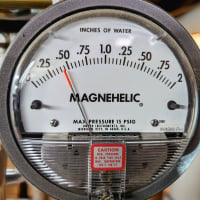11/16 OD copper pipe!? Can't find fittings
Comments
-
Yeah this isn't a good location for torch work. I'm thinking the best (safest) option is to cut the chrome pipe off, open the wall a little and put a 5/8" OD brass compression union (at the drywall) and add a couple inches of 1/2" pipe sticking into the room, and then a compression shutoff on to that.New owner of a 1920s home with steam heat north of Boston.
Just trying to learn what I can do myself and what I just shouldn't touch0 -
If you use a low flame torch tip and heat the tube away from the wall it will come off without the damage you are worried about. You have to remove it slowly, with a wrench on the end and the torch tip near the wall. It will work. Removing / cutting into the wall is a lot more work. You shouldn't have to do that unless as a last resort.0
-
Also there is a toilet in the way which makes all of it jut that much more difficult.0
-
@GW I see what you mean, the whole thing is a sleeve over the pipe, and I cut off the only good part to grab hold of. That totally went over my head when I dove into this without researching. ( truth be told I asked on a different message board since this wasn't Heating-related. Had I started here instead I'd be in a much better position to either do it right or I wouldn't have assumed I could do it myself.) Not knowing better assumed this was just a thicker walled nipple that had maybe a half inch of overlap with the pipe out of the wall. nope the thickness is the sleeve plus the pipe. live and learn.
I might try to peel it back a bit like @Intplm. suggested so that I'll have enough pipe beyond the drywall to attach a compression fit shut off. if not, I'll cut it, open the wall a bit and add a compression union and a nipple to work with.New owner of a 1920s home with steam heat north of Boston.
Just trying to learn what I can do myself and what I just shouldn't touch0 -
Flare fitting? With which size flare nut? Flare a chrome-sleeved 1/2" copper pipe? This is getting kind of confusing.0
-
@psb75 never mind. I think I got where I needed to be...I just made it a lot more difficult for myself by thinking I knew what I was doing two weeks agoNew owner of a 1920s home with steam heat north of Boston.
Just trying to learn what I can do myself and what I just shouldn't touch0 -
There's no harm in asking for help. I just worry about some of the potential "solutions" provided.0
-
@psb75 understood. I think I got more out of the general discussion rather than an explicit set of how to's. and I'm good with that. Most importantly, I found out I was trying to attack a situation that I wasn't actually in! And that made my situation harder to get out of. I now know that I do have standard pipes sizes here and that openes up a lot of standard tools and fittings to explore. Since I've shorted this stub so much now (not realizing it was a sleeve over the stub), I want to avoid solder for now as I have no good way to protect the upstream tee from melting and dont want to have top open up the wall to deal with it. Had I come here first, I would not have approached this problem at all like I did two weeks ago.New owner of a 1920s home with steam heat north of Boston.
Just trying to learn what I can do myself and what I just shouldn't touch0 -
I think we all learned a lot. Thanks!8.33 lbs./gal. x 60 min./hr. x 20°ΔT = 10,000 BTU's/hour
Two btu per sq ft for degree difference for a slab0 -
If you slice it up, you could also potentially get the pieces off with a 100w iron like this:
https://www.rings-things.com/Products/Soldering-Irons-and-Tools-for-Soft-Solder-Jewelry/Choice-trade-100W-Soldering-Iron.html
You will have to file/sand the chrome off and use some flux for the solder to wet that piece and transfer the heat.0 -
Are we sure that is a sleeve over the tube, and not just coated? The picture of it cut off, and the od measurement,looks like it isn't but I am not sure. I did not know they made those with a sleeve on them, so that makes it more difficult for sure.
Rick0 -
@Zipper13 Before you remove the toilet. And you might have to. Get a very small and sharp wood chisel. Try to gently tap/hit between the end of the copper tubing and CP tube. This can provide an end point. Or, something to grab onto with pliers. Then with a little of the pealed chrome off the copper, heat it with a torch. While heating, pull the chrome off as if you were removing a soldered copper fitting, cause in actuality, you are.
Best of luck to you. This can and has been done before.1 -
-
-
>
> I might try to peel it back a bit like @Intplm. suggested so that I'll have enough pipe beyond the drywall to attach a compression fit shut off. if not, I'll cut it, open the wall a bit and add a compression union and a nipple to work with.
Ok I hope it works, not a good thing if you’re not super comfortable with a torch0 -
It looks like that was probably put on before the baseboard but that giant escutcheon is to give it enough clearance from the wall to sweat it. A small pencil torch is a lot more controllable than the ts-8000 i use fore most things.0
-
-
I got the sleeve off.
I slowly filed a line longitudinally across the top until I saw silver. Heated it and with the tang of the file put pressure on the back lip of the sleeve kind of how @george_42 suggested with the open wrench. No binding and it slid right off. just need to clean the stub and attach the compression fit shut off. I didn't open the wall at all yet, but I will anyway to verify that I didn't melt the upstream tee and cause any leaks. I've made enough mistakes on this already. No good reason not to open up and be sure.New owner of a 1920s home with steam heat north of Boston.
Just trying to learn what I can do myself and what I just shouldn't touch5 -
Excellent !0
-
you are well on your way to be a master plumber, george0
-
great job!!!!0
-
> @Zipper13 said:
> I got the sleeve off.
> I slowly filed a line longitudinally across the top until I saw silver. Heated it and with the tang of the file put pressure on the back lip of the sleeve kind of how @george_42 suggested with the open wrench. No binding and it slid right off. just need to clean the stub and attach the compression fit shut off. I didn't open the wall at all yet, but I will anyway to verify that I didn't melt the upstream tee and cause any leaks. I've made enough mistakes on this already. No good reason not to open up and be sure.
Post a pic of that!
And hurry up and finish. I've been clenching my butt cheeks for 3 days.2 -
-
Wow, I have never seen this wrench.I Love It!!!!!!!!!
0 -
I think one of the electric clamp type pipe soldering tools might work on that thing. Might work.
However.
Much as I appreciate @rick in Alaska 's comments, if the wall is older lathe and plaster, which it looks as though it might be, using a torch anywhere near it is a major fire hazard. The lathe inside the wall is not protected by the plaster (or much of anything else, comes to that) and has rather fine slivers all over it, and it will be very dry. In the camping and bush trade it's called "tinder". The heat from soldering alone won't -- usually -- ignite it, though it may char. An errant flame -- even momentarily -- will ignite it. Inside the wall, where you can't see it. This can ruin your whole day... although if you notice it for some reason fast enough, and have an axe or a sledge handy, you can usually pull the fire down and out before the fire trucks get there.Br. Jamie, osb
Building superintendent/caretaker, 7200 sq. ft. historic house museum with dependencies in New England1 -
To conclude this learning experience of mine, here's the resolution to what turned out to be a very simple fix. In all, it was two hours from when we opened the wall to when it was closed up. I'm pleased.
I had my dad come by to supervise. He had some 1/2" pipe lying around (and I couldn't get in anywhere to buy any myself) and he has done this 100 times already so it was helpful to have him keeping an eye on this.
Toilet and stud placement didn't lend themselves to a large opening, so this was all pretty tight. we both agreed that I had definitely melted that elbow in my earlier work trying to get teh sleeve off and saw some questionable gaps in the elbow solder. So since that needed to be redone, I also opted to replace the short cut down stub with a longer one for more room to work with and easier replacement 20 years form now (fingers crossed).
the bathroom wall is newer wall board, the back of the wall is 100 year old plaster. Flammability being a concern, we sprayed the inside of the wall above and around the opening, laid some damp rags inside and placed a 1/8 aluminum plate (barely fit in the hole) right behind the elbow. my hope was that would absorb most of the heat. and it seems like it worked fine.
I didn't think about snapping any pics until i started to close it up. I screwed in two vertical piece of strapping to help reseat the piece of drywall that was cut out.
cut a replacement bell to contour the baseboard and fit it back in. I haven't spackled it in yet as I want to check the elbow now and again for leaks before it's buttoned up for good. I figure I'll get a chromed split sleeve (I'm sure it's called something else, but I've seen it out there pretty cheap) to cover up the copper later, but for now It looks fine to me.
thanks for all the feedback. I should have done this two or three weeks ago instead of trying to work out a "simpler" way to work with what was there and bodge something together. the actual job took a fraction of the time that I spent trying to find products I could repurpose and reshape to work.
New owner of a 1920s home with steam heat north of Boston.
Just trying to learn what I can do myself and what I just shouldn't touch5 -
I ran across the exact same issue. I too cut off the existing fitting and left myself no purchase to sweat off the pipe (I tried). After measuring the pipe at 0.700" with calipers, searched on the nearest sixteenth: "11/16 OD copper pipe" and found this thread.
But I really didn't want to open the wall. For anyone that finds this thread in future, and is looking for a fix without opening the wall, read on.
Armed with calipers, the key was finding this 1/2" x 3/8" adapter in Home Depot:
OD of the 3/8" end is 0.583".
Bought a 19/32" = 0.59375" drill bit from Amazon. 0.01" larger than the OD of the 3/8" end of the adapter. Drilled out about 1/2" of the end of the stub from the wall. That leaves a wall diameter on the stub of over 0.1" (or half that) which is larger than the wall diameter of type L 1/2" pipe at 0.08", so I figured that was still plenty thick enough.
Sweated the 1/2" end of the adapter onto a piece of 1/2" pipe, then sweated the 3/8" end of the adapter inside the stub from the wall:
(Using the clamp onto the dewalt drill base to hold the whole thing steady. Two Oatey heat pads to prevent burning the wall and floor when sweating. Blue tape on the floor was because I decided to repaint the baseboards behind the toilet while it was out).
Final result with compression fitting (I forgot the escutcheon - he who has never done so feel free to laugh at me. I added a split one after):
Probably not code. But then I'm definitely not a plumber, so all fair.0 -
Cool- glad you made it work. Most plumbers wouldn't drill the fittings, as to lessen the wall thickness. I'm sure it's fine, good job.
—Escuction, you would have scorched it with the flame that close. That's the whole general purpose of the sleeved supply tube.
0 -
could probably swedge a fitting or tube to make it fit over the od too
0 -
Thanks. I was worried about the wall thickness which was why I looked up the thickness of 1/2" to make sure I wasn't going too thin. I was concerned the drill might not center itself but it went in perfectly. Copper being so soft helps a lot.
I forgot the escutcheon after I finished the soldering. Should have put it on before the compression fitting but I was too excited that it seemed to be working out, I got ahead of myself. Then I did not want to try and remove the compression ring, so I just left it.
0 -
they make 'split' ones, they are very popular
https://www.supplyhouse.com/Wal-rich-1731602-1-2-Copper-Plastic-Split-Escutcheon-5-8-OD
0 -
Yup, split was what I used.
0 -
Yeah, I bought a swaging tool, but this way felt more idiot-proof to this idiot.
0 -
-
I may have done this with solder when i had a supply line that was too short and i had a scrap piece of half inch tubing but not a longer supply line.
0
Categories
- All Categories
- 87.3K THE MAIN WALL
- 3.2K A-C, Heat Pumps & Refrigeration
- 61 Biomass
- 427 Carbon Monoxide Awareness
- 119 Chimneys & Flues
- 2.1K Domestic Hot Water
- 5.8K Gas Heating
- 114 Geothermal
- 165 Indoor-Air Quality
- 3.7K Oil Heating
- 76 Pipe Deterioration
- 1K Plumbing
- 6.5K Radiant Heating
- 395 Solar
- 15.6K Strictly Steam
- 3.4K Thermostats and Controls
- 56 Water Quality
- 51 Industry Classes
- 50 Job Opportunities
- 18 Recall Announcements













